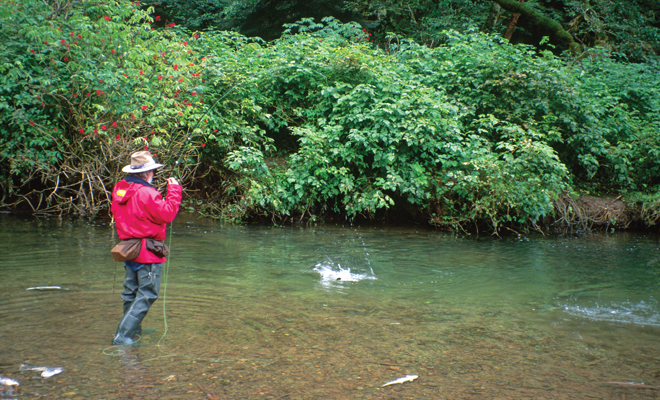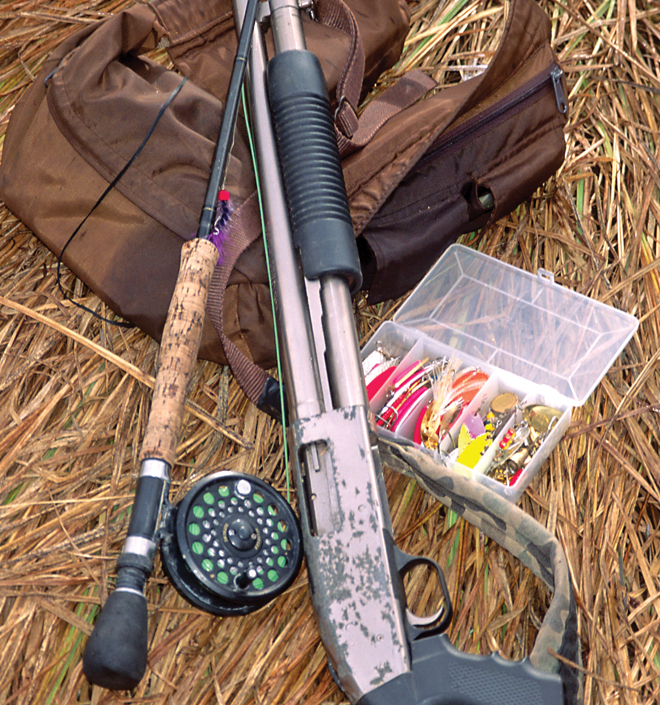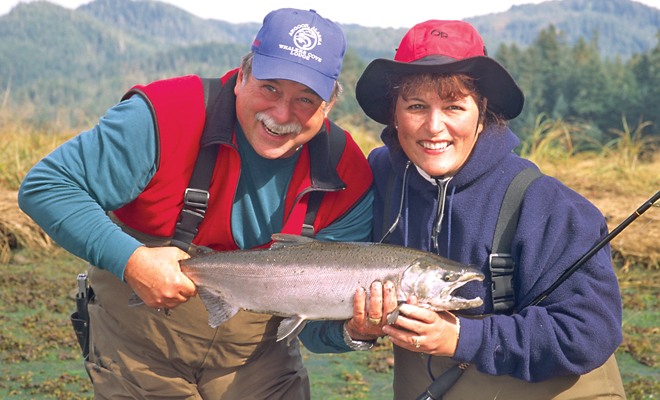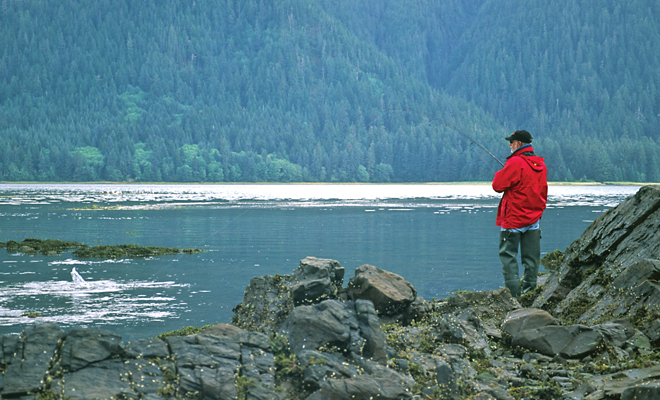
By Terry W. Sheely
I was being warned: “Leave now ’n you’ll miss the biggest, meanest silvers of the year. Fish through September into October if the weather lets you. That’s when the big hooknoses come through and there’s nobody here. Just you and the fish and maybe a bear or two.”
Ten years ago my incidental advisor was wearing waders, earning summer pay as a river fish guide but he still knows the fight, the timing, the fish, and his advice is an annual arrow into my soul.
Not a salmon season falls into winter that I don’t think of his sage instruction and regret the tail-end silvers I’m no doubt missing because of some sorry distraction. Unfortunately, late fall is flush with mountain-and-stream distractions, many of which have something to do with shooting, drying, vacuum-packing and smoking things fit to eat. The others—weather, work, yard chores, football—are only lame excuses.
As my ex-guide advisor well knew, September and October silvers are at least a month bigger and fatter than their intensively fished early-run relatives. Bucks are thick through the shoulders, hook-jawed to the point of appearing evil, can be nasty with attitude hanging on short tempers, and are pretty much ignored by a fishing public fighting singular distractions. Hens go wild on the surface and get etched into memory.
In the course of a year, I tangle with my share, probably more than my share, of salt- and freshwater kings, coho, hallies, rockfish, trout, steelhead, Dollies and others, but if I had to give it all up for late-run, hooknose silvers it would be a fair deal.
There is an addiction inherent in sight-fishing skinny, clear water, scrambling for position to present to the surging black shadows of big fish on the move, and the eruptive craziness of berserk coho catapulting cartwheels through river spray.
It doesn’t hurt that most skinny-water hooknose encounters are played out in pleasant arenas scented with soft river smells and crushed leaves, the last breath of a summer dying, the slap of new cold, and a congenital command to fulfill a final fish trip—to feel just one more time a good tug before the snow.

“Sometimes it’s just you, the salmon and the bears.”
Silvers are caught by anglers working the powerhouse rivers, those major swaths of water that measure an honest half-mile wide and are colored with glacier flour. But for the most part silvers are creatures best sought higher in the watershed in small water. Silvers spawn in shallow headwater creeks with their backs out of water and skin falling off. To get there they migrate up a progressively narrowing funnel, each tributary of the funnel smaller and tighter than the last.
I prefer to stake my fighting ground at the top of the funnel, where small freshwater spills into salt. Here, the fish are still fat with Pacific herring and shrimp, bright with ocean water and bristled with sea lice. They are as physically fit as they ever will be, and I believe a bit thin-skinned and prone to pick fights with irritants—like a No. 4 Blue Fox spinner or impudent Egg-sucking Leech with its gauzy dressing and brash red face.
Most mature Alaska silvers are in their natal rivers by late August, early September at the latest, but there are always laggards, tail-enders that stay at sea too long then come inland in a rush, storming the estuaries, impatient to get on with the business of metaphorical legend.
And of the 1.4 million coho caught in Alaska each year only a select few rivers support good numbers of October fish—the beasts of the bunch. I have no way of knowing for sure, but I suspect the 26-pound state record caught out in Icy Strait was headed for a Southeast late river.
In Southcentral, Twentymile River, which flows into the upper end of Turnagain Arm, gets a solid run of silvers in October, one of the latest runs in the state. October silvers, according to ADF&G studies, are also in the Talkeetna River during the early part of the month, some hanging on throughout.
But back to Southeast, October silvers are fairly common in the small streams around Yakutat, Juneau, Haines, Skagway and Sitka. This region, in fact, is pegged as having some of the longest lasting silver salmon runs in the state. Yakutat is especially prone to late silver runs. Bright silvers will be climbing Southeast rivers long after most outdoorsmen have racked the rod and picked up the rifle.
In the southern part of Southeast, October hooknoses are even more common, often appearing in small streams through mid- to late-month around Petersburg, Wrangell, Ketchikan and on Prince of Wales Island.
Not all of the best come back in October—just the biggest of the best. There’s also a wealth of nasty skinny water in mid-September in Resurrection Bay, off
Whittier and up Campbell Creek in the Anchorage-Seward region. The popular Susitna River gets a big run of silvers (usually the fourth largest sport catch in the state) but most are in by Labor Day.
The Kenai and Kasilof rivers attract spurts of silver schools through September and into early October, and over around Valdez and Whittier the roadside streams will offer big silvers into late September, some going into early October. The Eyak River and streams around Cordova are productive through late September.

Jim Tuggle and wife Susan stage a pose for the family scrapbook with her Admiralty Island silver.
Unless you live there, Kodiak Island may be a bit remote late in the year when the weather can turn, but if you’re in the neighborhood ask about the bunch of streams bulging with early October silvers.
ADF&G reports that some rivers attract bright coho into November, but this is rare and most will swim upriver unmolested. As a rule, the longest rivers receive their silvers early in the season because these fish have a long way to go.
Conversely, most late-running silvers are found in small, short rivers where the cadre of spawning coho can remain feeding in saltwater as long as possible and then make a quick, hot dash to spawning areas.
These are my fish, the mid-September into October silvers, the ones too big to turn away from a fight, too late to invest in a prolonged sulk, too ornery to step aside. It wouldn’t surprise me to learn some day that it is the silver salmon that goes looking for brown bears to whup and not the other way around. That they always lose is of no consequence. Silvers are born aggressors and to bullies it is always the fight that is important.
Which is why I’m just about to jerk-strip my swinging red leech, to make the scarlet marabou flare and show its white underwraps just when it drifts into the face of the big buck that a few minutes ago I saw power up the tailout riffle. The silver moved into the shadow of the cutbank and bellied down to recover from the exertion. Three other shadows are laid up in the dark with my target fish, all smaller.
We’re a little over halfway through September and this stream sliding off southwest Admiralty Island is typically low and clear. It’s 10 to 20 yards wide, deep under the cutbacks, shallow inside the bends. I can wade across it almost at will and the salmon migration channels are easy to pick out.
No matter what region of the state they call home, silver salmon appear to recognize how vulnerable they are under skinny-water conditions and they stick their shadows into whatever cover is available. I’ve seen schools string out head-to-tail to move upstream under the skinny shadow of a singular fallen Sitka spruce log.
This makes them predictable.
As long as big rains hold off and the low, clear conditions persists, almost every silver that comes into a stream will follow the exact same course upriver. If you nail fish in a shadow trough along a deep ledge on Tuesday, you’ll find the next run of fish in the same place on Wednesday. It’s sight-fishing but instead of seeing the fish you cast to the place where it hides and travels.
And sometimes, the best times, it boils down to sight-fishing for a fish you can see.
Like this time.
I’m fishing a 7-weight fly rod with a floating line and 15 feet of sink-tip with a 3-foot shock leader of 30-pound mono, and a short 18-inches of 10-pound 2X tippet. It’s an effective combination for this situation, presenting the fly tight to the bottom without the kiting effect of more traditional-length leader-tippet combos. I’m no purist and if a situation requires going deeper to reach fish, I carry a case of micro-split shot. What’s important is getting the fly in front of the fish. Some will chase it, some won’t. I want them both.
The gaudy marabou red streamer with the white underpants was cast slightly across stream and swung into position a dozen feet directly above the targeted silver. I’m kneeling in the pea gravel and skinny water, trying to be invisible. With up and down flips of the rod tip, I buck humps of slack line downstream, the fly sinks and drifts with the tailout current straight toward the silver. Its mouth opens and closes, flashing white in the shadows. When I judge the fly to be a foot in front of and eye-level with the salmon I hard-strip the taut line, causing the bright marabou to flare and dance and the hooknose eats it.
That’s how it should have gone,
Instead, when I bounce the marabou a 12-pound hen streaks out of the shadows, passes the bigger buck and inhales the streamer. It continues straight upstream like a rifle shot, porpoises across the surface six feet in front of me and is gone. It was over in a heartbeat, long before a hook set, long before the adrenalin kicked in.

In the splattering of light and water a silver leaps at the end of Jim Goerg’s spinning gear in the first pool above saltwater.
Downstream, in the pool below the tailout, my fishing buddy hooks up and hollers. Jim is using a spinning rod, throwing a No. 4 red spinner with a bright nickel blade modified with a single-Siwash hook. It’s the sixth silver he’s hooked with this rig and this is a good one. It’s a nasty-buck with an evil hooked kype that wallows head and shoulders through the surface before gaining its balance and rocketing cross-stream. Jim’s light rod bucks, line squirts off the reel and everybody grins.
The techniques for catching fall silvers are as basic as bricks.
Fluorescent red clusters of juicy salmon eggs and single eggs presented on drift sinkers in big water or under a float in streams; gaudy streamer patterns, egg ties, Pixie-style spoons, or spinners in the No.4 range. Colors almost always depend on water clarity, and the mood swing of the silvers that day. Every silver box of lures needs patterns in red and blue and green, with most in gaudy fluorescence. I’ve caught silvers on purple flies, orange spinners and black spoons with yellow dots. With late silvers it’s a crap shoot—bring the big box.
Not that October silvers are always picky. I’ve enjoyed glorious days when silvers chased and crushed almost every lure or fly thrown in their general direction. And I’ve had days when they sulked and stewed with their mouths shut and their bellies on bottom and the only way to draw a strike was to provoke it. To bang the fish on the nose, to dance the lure between their eyes, to push the aggression button that triggers an involuntary strike—sometimes provocation is the only way.
The trick for fall salmon is to offer them something they want to kill and keep picking through the box until you find the key. Catch them the way they want to be caught, not the way you want to catch them.
There’s always a way, though, wherever the last silvers of the year roll into the skinny water before the snow.
Skinny Water: Silvers Before the Snow originally appeared in the August/September 2010 issue of Fish Alaska magazine.
